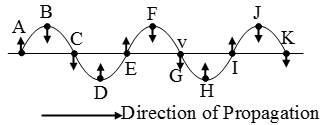What Is Wave Motion
Most of us have seen the formation of ripples when a small stone (pebble) is dropped into a pond. The disturbances created by the stone in the water produces ripples which move outwards towards the shore of the pond.
If you examine the motion of a leaf floating near the disturbance for a short while on a steady day, you would see that the leaf moves up and down about its original position, but does not move away or towards the source of disturbance. This indicates that the disturbance (such as a water wave) moves from one place to another, but the water is not carried with it. The water particles simply move up and down their mean positions.
The formation of ripples on the surface of water is an example of wave motion.
Wave Motion: The movement of a disturbance produced in one part of a medium to another involving the transfer of energy but not the transfer of matter is called wave motion.
Examples:
(i) Formation of ripples on the water surface.
(ii) Propagation of sound waves through air or any other material medium.
Terms Used For Defining Wave Motion
- Wave Length: The distance between two nearest points in a wave which are in the same phase of vibration is called the wave length. In simple words it is the length of one complete wave. It is denoted by lambda, λ.
- Amplitude: The amplitude of a wave is the magnitude of maximum displacement of the vibrating particles on the either side of their mean position. It is denoted by the letter A and its SI unit is metre (m).
- Time-Period: The time required to produce one complete wave (or cycle) is called time-period of the wave.
- Frequency: The frequency of an oscillating particle is the number of oscillations completed in one second. The unit of frequency is hertz (or Hz). The frequency of the wave is 1/T. It is generally represented by υ (nu)
- Wave Velocity: The distance travelled by the wave in one second is called the wave velocity. It is represented by ‘v’ and its unit is ms-1.

- Phase: All the points on a wave which are in the same state of vibration are said to be in the same phase. Thus, in the wave shown in fig.

(a) Points B, F and J are in the same phase – all lie on the crests.
(b) Points D and H are in the same phase – both lie on the troughs.
(c) Points A, E and I are in the same phase. All these points are just about to start their vibration in the upward direction from their mean positions.
(d) Points C, G and K are in the same phase. All these points are just about to start their vibration in the downward direction from their mean positions.
Periodic Motion
(i) When a body repeats its motion continuously on a definite path in a definite interval of time then its motion is called periodic motion.
(ii) The constant interval of time after which the motion is repeated is called the ‘Time period of motion.’ (T)
Example: Time period of hour hand is 12 hours.
Oscillatory Motion
(i) If a body in periodic motion moves along the same path to and fro about a definite point (equilibrium position), then the motion of the body is a vibratory motion or oscillatory motion
Note: Resultant force acting on the particle is zero in equilibrium condition.
(ii) It is to be noted here that every oscillatory motion is periodic but every periodic motion is not oscillatory
Characteristics Of Wave Motion
The main characteristics of wave motion are described below:
- In wave motion, the particles of the medium vibrate about their mean positions. The particles of the medium do not move from one place to another.
- A wave motion travels at the same speed in all directions in the given medium. The speed of a wave depends upon the nature of the medium through which it travels.
- During a wave motion, energy is transferred from one point of the medium to another. There is no transfer of matter through the medium.
